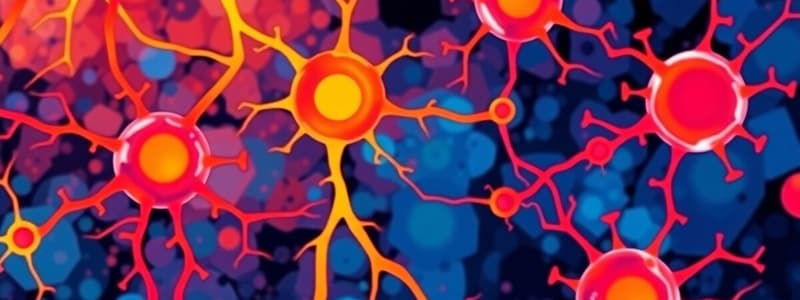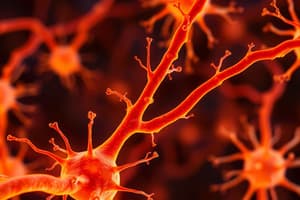Podcast
Questions and Answers
What is the primary structural difference that allows human neurites to conduct signals significantly faster than cuttlefish neurites?
What is the primary structural difference that allows human neurites to conduct signals significantly faster than cuttlefish neurites?
- Human neurites have a smaller diameter, reducing resistance to signal flow.
- Cuttlefish neurites lack the nodes of Ranvier, which are essential for rapid signal transmission.
- Cuttlefish neurites have a higher concentration of ion channels, slowing down signal propagation.
- Human neurites possess myelin sheaths formed by glial cells, enabling saltatory conduction. (correct)
Based on the data provided, which of the following statements accurately compares the average conduction velocities of neurites with and without myelin sheaths?
Based on the data provided, which of the following statements accurately compares the average conduction velocities of neurites with and without myelin sheaths?
- Neurites with myelin sheaths conduct signals approximately 5-10 times faster than those without. (correct)
- Neurites with myelin sheaths conduct signals approximately 2-3 times faster than those without.
- Neurites without myelin sheaths conduct signals at a slightly faster rate due to the absence of insulation.
- The presence of myelin sheaths has no significant impact on the conduction velocity of neurites.
A researcher is investigating the effect of temperature on nerve conduction velocity. Which experimental setup would provide the MOST relevant data based on the information provided?
A researcher is investigating the effect of temperature on nerve conduction velocity. Which experimental setup would provide the MOST relevant data based on the information provided?
- Measuring the change in action potential amplitude in cuttlefish neurites at different temperatures.
- Observing the frequency of neurotransmitter release at a synapse under varying temperature conditions.
- Comparing the conduction velocity of myelinated neurites at room temperature versus body temperature. (correct)
- Analyzing the resting membrane potential of nerve cells after exposure to different temperature gradients.
Which of the following best explains why more highly developed organisms benefit from faster signal transmission in their nervous systems?
Which of the following best explains why more highly developed organisms benefit from faster signal transmission in their nervous systems?
Curare causes paralysis by interfering with signal transmission at the neuromuscular junction. Based on this information, which cellular component is MOST likely affected by curare?
Curare causes paralysis by interfering with signal transmission at the neuromuscular junction. Based on this information, which cellular component is MOST likely affected by curare?
Why was artificial ventilation essential for patients undergoing surgery with curare?
Why was artificial ventilation essential for patients undergoing surgery with curare?
If a drug blocks the voltage gated-potassium channels in a neuron, what effect would this have on the action potential?
If a drug blocks the voltage gated-potassium channels in a neuron, what effect would this have on the action potential?
Consider a scenario where the concentration of sodium ions outside a neuron is significantly reduced. How would this affect the neuron's ability to generate an action potential?
Consider a scenario where the concentration of sodium ions outside a neuron is significantly reduced. How would this affect the neuron's ability to generate an action potential?
A scientist discovers a new neurotoxin that prevents the release of neurotransmitters from the presynaptic neuron. What direct effect would this neurotoxin have on signal transmission across a synapse?
A scientist discovers a new neurotoxin that prevents the release of neurotransmitters from the presynaptic neuron. What direct effect would this neurotoxin have on signal transmission across a synapse?
How does an increased diameter of an axon affect the speed of signal transmission, and why?
How does an increased diameter of an axon affect the speed of signal transmission, and why?
Flashcards
Conduction Velocity
Conduction Velocity
The speed at which an electrical signal travels along a neuron.
Neurite (Human)
Neurite (Human)
A type of nerve cell extension optimized for rapid signal transmission.
Neurite (Cuttlefish)
Neurite (Cuttlefish)
A nerve cell extension, typically with slower signal transmission compared to human neurites.
Schwann Cells/ Myelin Sheath
Schwann Cells/ Myelin Sheath
Signup and view all the flashcards
Synapse
Synapse
Signup and view all the flashcards
Curare
Curare
Signup and view all the flashcards
Cell Body (Soma)
Cell Body (Soma)
Signup and view all the flashcards
Axon
Axon
Signup and view all the flashcards
Dendrites
Dendrites
Signup and view all the flashcards
Advantage of Developed Organisms (Nervous System)
Advantage of Developed Organisms (Nervous System)
Signup and view all the flashcards
Study Notes
- Nerve cells structure is discussed
Signal Transmission (Material A)
- Conduction velocities over 130 m/s in humans are only possible due to the special structure of the neurites
- Signal transmission in squid and humans is compared using models and neuron structures
- Differences in neuron structure between squid and humans affect signal transmission
- Higher developed organisms benefit from faster signal transmission
- Squid neuron signal speed is 25 m/s
- Human neuron signal speed is 130 m/s
Conduction Velocities (Material B)
- Conduction velocities were measured in animal experiments
- A table shows conduction velocities (m/s) for neurons with and without myelin sheaths across 10 measurements
- Neurons with myelin sheaths (frog): Values range from 60 to 90 m/s
- Neurons without myelin sheaths (squid): Values range from 5 to 10 m/s
- The average conduction velocity should be calculated, and the values should be interpreted.
Signal Transfer (Material C)
- Parts of a nerve cell and synapse are labeled with letters
- Signal transmission from a nerve cell to a muscle cell is illustrated
- A, B, and C are parts of the muscle fibre
- D, E, F, G, and H, are parts of the synapse
Deadly Nerve Agent (Material D)
- Curare, a South American arrow poison, paralyzes muscles and causes respiratory arrest
- Curare was previously used during surgeries to relax muscles
- Curare's use in surgeries became possible once artificial respiration for patients was available
- Curare affects signal transmission, as illustrated in diagrams 5-7
Studying That Suits You
Use AI to generate personalized quizzes and flashcards to suit your learning preferences.




